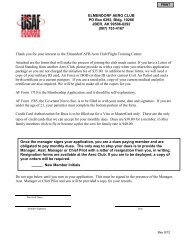C172 Maneuvers Guide - ELMENDORF AERO CLUB
C172 Maneuvers Guide - ELMENDORF AERO CLUB
C172 Maneuvers Guide - ELMENDORF AERO CLUB
You also want an ePaper? Increase the reach of your titles
YUMPU automatically turns print PDFs into web optimized ePapers that Google loves.
BACK TO BASICS<br />
1. Every maneuver begins and ends the same way: SLUF (Strait and Level<br />
Unaccelerated Flight – i.e.; cruise power, trimmed, on altitude and heading, and<br />
stabilized). That way, you know exactly when you are beginning the maneuver,<br />
and exactly when you are done.<br />
2. The recovery altitude is the altitude you are at when you are finished with the<br />
maneuver (i.e.; SLUF). It will probably be different than the altitude from which<br />
you started the maneuver. That being said, your instructor may want you to<br />
return to your original altitude after recovering from a power off stall.<br />
3. There is no requirement to establish a positive rate of climb when recovering<br />
from a stall in a fixed gear aircraft. (The PTS only requires a positive rate of<br />
climb prior to retracting the landing gear.) However, the aircraft should be in a<br />
pitch attitude that will result in a positive rate of climb at the end of the maneuver.<br />
4. To consistently raise or lower the flaps “incrementally,” use airspeeds that equate<br />
to something useful. Pattern airspeeds work well for extending the flaps and<br />
V-speeds work well for retracting them during a stall recovery or a go-around.<br />
5. Clearing turns will be accomplished by turning 90 degrees in each direction.<br />
6. The importance of proper trim techniques cannot be over emphasized. Trim<br />
constantly changes throughout the flight. Any change in power, pitch, bank,<br />
airspeed or weight/CG (fuel burn) requires a corresponding trim change. You<br />
should constantly strive to keep the aircraft trimmed “hands off.” A properly<br />
trimmed aircraft will allow you to do other things with your eyes and hands (e.g.<br />
surveillance, taking notes, inserting coordinates in the GPS) without having to<br />
constantly monitor altitude, airspeed and heading.<br />
7. The following maneuver descriptions are designed to produce standardized<br />
performance by each Pilot. Therefore, they should be considered procedural in<br />
nature. By performing each maneuver as described, you will consistently fly the<br />
aircraft (and think through the maneuver) the same way every time. This will<br />
develop a sound knowledge and flying skills base and allow you to handle any<br />
emergency or unusual flight situation in a predictable fashion based on a solid<br />
foundation of the basics.<br />
4



